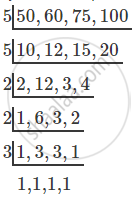Advertisements
Advertisements
Question
The circumferences of four wheels are 50 cm, 60 cm, 75 cm, and 100 cm. They start moving simultaneously. What least distance should they cover so that each wheel makes a complete number of revolutions?
Solution
Distance covered by a wheel for one complete revolution = circumference of the wheel
All the wheels will make complete numbers of revolutions when the distances covered by them is equal to their LCM.

Required least distance = 5 × 5 ×2 × 2 × 3
= 25 × 4 × 3
= 300 cm = 3 m
So, each wheel will make a complete number of revolutions after travelling 3 m.
APPEARS IN
RELATED QUESTIONS
An equal number of laddoos have been placed in 3 different boxes. The laddoos in the first box were distributed among 20 children equally, the laddoos in the second box among 24 children, and those in the third box among 12 children. Not a single laddoo was leftover. Then, what was the minimum number of laddoos in the three boxes altogether?
Find the LCM:
15, 30, 90
Find the LCM:
63, 81
Find the LCM of the numbers given below:
42, 63
The product of two numbers is 2160 and their HCF is 12. Find their LCM.
Find the LCM of the numbers 16, 20, 80.
Find the LCM set of numbers using prime factorisation method.
10, 15
Find the smallest number which is exactly divisible by all the numbers from 1 to 9
Arun and Shahjahan goes for walking in a circular path of a park in the same direction. Arun takes 6 minutes to complete one round, while Shahjahan takes 8 minutes to complete one round. In how many minutes will they meet each other?
There is a garden in Anu’s house. In the middle of the garden there is a path. They decided to tile the path using tiles of length 2 feet, 3 feet and 5 feet.
The mason tiled the first row with 2 feet tiles, the second row with 3 feet tiles and the third row with 5 feet tiles. The mason has not cut any of the tiles. Then what is the shortest length of the path?
